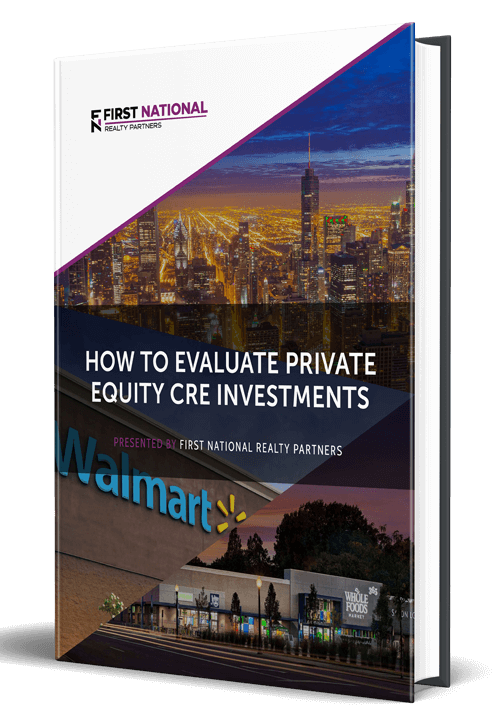An Investor’s Guide To Real Estate Syndication Structures
Commercial real estate properties, especially those in the most desirable locations, are incredibly expensive and typically out of reach for all but the most well funded individual investors. For this reason, they are rarely purchased by just one person. Instead they are typically purchased by groups of individuals who come together to pool their capital to obtain the equity financing needed. This group is known as a “syndicate.”
In this article, we are going to describe common syndication structures. In doing so, we will describe what they are, how they work, how profits are divided, and the pros and cons of using this approach to real estate investment. By the end readers will have the information needed to determine if a syndicated investment is a good fit for their own preferences.
At First National Realty Partners, we are a private equity firm who specializes in the purchase and management of grocery store anchored retail centers and, before committing to any transaction, we always use NPV to assess potential profitability. If you are an accredited investor, interested in partnering with a private equity firm to allocate capital to a commercial real estate investment, click here.
What is a Real Estate Syndication?
“Syndication” or “syndicate” is just a financial term for a group.
So, in a commercial real estate context, a syndication refers to a group of investors who pool their capital to purchase a property. When working with large, institutional quality assets, there are two reasons why this structure makes sense:
- Cost: As described in the introduction, institutional quality commercial real estate assets are incredibly expensive. For example, many of the properties we purchase are $20MM or more. So, it makes sense for investors to come together to make the purchase.
- Expertise: In addition to being very expensive, large commercial properties can also be incredibly time consuming to manage. There is a lot of work that goes into collecting rent, negotiating leases, making repairs, and working with lenders. For this reason a syndicated structure can be helpful because they typically come with a leader (who is often a real estate firm like us) that has the time, resources, and expertise to manage the property on behalf of the group.
To support these needs, a commercial real estate syndicate has a very specific structure.
What is the Structure of a Real Estate Syndication?
The structure of nearly all commercial real estate syndicates is the same and it involves two types of members, the General Partners and the Limited Partners.
The General Partner is the deal leader and they are responsible for finding the property, arranging both the debt and equity financing, completing all due diligence, and for all property management tasks. In short, they handle all of the logistics of the deal. To do so, they must have the experience, expertise, track record, and resources necessary to lead a large deal, meaning that they are usually a private equity real estate firm (like us) or an impeccably credentialed individual. To signal their commitment to a deal, they will usually invest around 10% of the total capital needed to get a deal closed.
Limited Partners are individually accredited investors – who meet minimum income and net worth requirements – that wish to participate in the syndicate with the hope of earning a return on their investment. The Limited Partner role is completely passive, meaning that they do not typically have any say in day to day property management decisions and no say in when a property is sold or for how much.
Example
To illustrate how these two types of members work together, an example is helpful.
Suppose that a real estate firm comes across a multifamily apartment building that they believe is a good deal and they put it under contract for $10 million. As part of the purchase, they also arrange debt financing with a real estate lender for $7.5 million, meaning that they need $2.5 million in equity to complete the purchase. To get it, they first commit $250,000 of their own money as a sign of their commitment to the deal. Then, they put together a pitch deck and solicit individual investors for the remaining $2,250,000 needed.
In this example, the real estate firm is the GP in charge of finding, financing, and managing the property. The LPs are the investors who commit money to the deal. Both parties earn income and profits , but the exact split can vary depending on the terms of the deal.
What is the Split Structure of a Real Estate Syndication?
Remember, the point of a syndicated structure is to buy a large, profitable property. Operating expenses are deducted from rental income and any money left over creates a pot that is available to be distributed to GP and LP investors. The exact split will be in accordance with the terms of the deal, and they can vary, but it usually falls into one of two categories.
Straight Split
The straight split is exactly what it sounds like. In it, any funds available for distribution are divided evenly between the GP and the LP based on their percentage of ownership.
In the example above, the GP put in 10% of the total equity needed and the LPs put in 90%. So, in a straight split scenario, the GP would get 10% of the money available for distribution while the LPs/passive investors would get the remaining 90% in proportion to the number of shares they each own.
The straight split is perhaps the easiest and cleanest way to split the profits in a syndicated commercial real estate investment opportunity. But, the major issue here is that the GP/deal sponsor is doing all of the hard work to manage the property and they should be incentivized to deliver the highest possible return. For this reason, the “waterfall” distribution structure is more common.
Waterfall Distribution
When a commercial real estate syndication deal has a waterfall structure, it simply means that the GP/LP split can change based on certain predetermined thresholds. These can become very complicated, but for the sake of simplicity, consider the example above where the GP put in 10% of the total equity needed and the LPs put in 90%.
In a waterfall, the cash flow split may be pro-rata when the property delivers a rate of return between 0% and 6%.
But, if the return goes above 6%, the split may change so that the GP gets 20% of the cash available for distribution while the LPs get 80%. This extra 10% for the GP is often referred to as a “promote” and it is designed to be a bonus for their profitable management of the asset. The idea here is that the bonus will give the GP the needed motivation to deliver a return higher than 6%. When this happens, both parties should be happy, the GPs because they got a 10% bonus and the LPs because they are earning a high return.
How Does a Real Estate Syndication Make Money?
There are two ways to think about how a syndication makes money, from the perspective of the GP and from the perspective of the LP.
From the perspective of the GP, a syndication makes money from two places.
First, a GP may charge fees for their stewardship of the investment. For example, they may charge origination fees, asset management fees, acquisition fees, or disposition fees. These fees should not make up a significant portion of the profit. Instead, they should be enough to run the deal and manage the property.
The major source of profit for the GP typically comes from the “promotes” earned over the life of the deal because they are disproportionate to the amount of money the GP puts into the deal. In the example above, they only put in 10% of the required capital, but earn 20% of the profits if the property performs well. This can be particularly lucrative if the property is sold for a big profit at the end of the holding period.
From the perspective of the LP, the major source of profit comes from the recurring, passive income, earned from the property and from any major capital gain upon sale of the property – which can be significant.
Are Real Estate Syndications a Passive Investment?
For the GP, a real estate syndication is not a passive investment. There is a lot of work that has to go into finding, financing, and managing a property and it is anything but passive.
For the Limited Partnership (LPs), a syndication is a passive investment and this is one of the major attractions of it. LPs get all of the income and tax benefits of investment property ownership without the hassle of managing the property.
Which Real Estate Syndication Structure is the Best, and When?
It is difficult to say which type of real estate syndication is best, because they offer different advantages.
A deal structure that offers a straight split may be a good fit for investors who prefer clean, simple deals where the split is equitable relative to the amount of capital contributed, easily predictable, and relatively stable.
A waterfall distribution structure may be a better fit for investors who want to push their GP partners to deliver the highest possible return and are willing to sacrifice some share of their own cash flow to get it.
How to Find a Real Estate Syndicate?
It is important to note that real estate syndications are typically only available to “accredited investors” who meet certain income and net worth criteria. While non-accredited investors may participate in some scenarios, it is more the exception than the norm.
There are three places that investors may find a syndicated deal to help meet their investment goals:
- Private Equity Firm: A private equity firm is a great example of a GP that does all of the hard work of raising capital and putting a syndicated deal together. There are dozens across the United States and they can be found through bankers, accountants, lawyers, industry relationships, or through an internet search.
- Crowdfunding Platform: A crowdfunding platform like Fundrise tries to make it easier for investors to find deals by advertising them all in one place, on their website, and by simplifying the logistics of bringing the deal together. A simple internet search can find a number of crowdfunding options.
While these options may have different legal structures and a different approach to raising real estate investor capital, they both provide investors with a chance to gain exposure to the commercial real estate asset class. One isn’t necessarily better than the other, but they are indeed different. Investors should carefully evaluate the nuances and make the choice that is the best fit for their own preferences.
Summary of Real Estate Syndication Structures
Because commercial real estate assets are very expensive, they are rarely purchased by a single individual. Instead, they are usually purchased by groups of investors who come together to pool their capital. This group is also referred to as a “syndicate.”
The structure of a typical syndication is that there are two groups of investors, the GP and the LPs. The GP does the hard work of forming the limited liability corporation and using it to find, finance, and manage a property. LPs provide capital, but have an otherwise passive role.
Income and profits produced by the property are usually split in one of two ways. The first is a straight split that is proportionate to the amount of capital each group contributes. The other is a “waterfall” structure that allows a disproportionate split based on predetermined thresholds.
For GPs, real estate syndications make money from fees and profits upon sale. For LPs, the syndication makes money from recurring payouts funded by rental income and the gain on sale.
One of these structures is not necessarily better than the other, but one may be a better fit for investor preferences. For this reason, investors should carefully study the nuances of each deal and choose the structure that is the best fit for their own needs.
Interested In Learning More?
First National Realty Partners is one of the country’s leading private equity commercial real estate investment firms. With an intentional focus on finding world-class, multi-tenanted assets well below intrinsic value, we seek to create superior long-term, risk-adjusted returns for our investors while creating strong economic assets for the communities we invest in.
If you are an Accredited Real Estate Investor and want to learn more about our investment opportunities, contact us at (800) 605-4966 or info@fnrpusa.com for more information.






